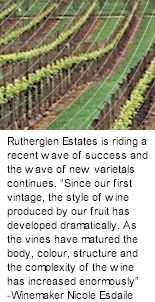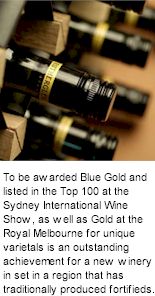About Rutherglen Estates - the Winery
Rutherglen Estates
The Rutherglen Estates wine range is inspired by the region’s traditions, and its climatic suitability for growing the classic grape varieties of the Rhone Valley and Italy
In 1996, after an extensive search for the area most suitable to produce an innovative range of wines, Rutherglen Estates was born. In order to ensure the ongoing development of the brand, the company was set up in conjunction with RV (Rutherglen Vineyards) Management, the viticultural arm of Rutherglen Estates, with vineyard development well underway by 1997. With new concepts, economic management and cutting-edge technology, RV Management is responsible for a total of 358 hectares of vines, making it the largest vineyard development that the Rutherglen region has ever seen.

Fittingly, the Rutherglen Estates vineyards are home to plantings of Durif, Shiraz, Grenache, Mourvedre, Nebbiolo, Sangiovese, Viognier and Marsanne. The wines achieve a balance between modern and classic styles and this theme recurs in the state-of-the-art winery. The very best of contemporary technology combined with some older and traditional techniques, enables the winemaking team to produce exciting wines that consistently offer great quality and value.
The new millennium saw the development of the Rutherglen Estates’ winery, one of the most modern wineries in Australia. The first Rutherglen Estates vintage was produced in 2001, and subsequently just one wine was released, the 2001 Rutherglen Estates Durif. Despite the youth of the vines, this inaugural release was awarded a Commendation at the Rutherglen Wine Show (2001) and a Seal of Approval at the London International Wine Challenge (2002). This heralded the start of continuing wine show success and accolades for the Rutherglen Estates range of wines in Australia and overseas.
The varieties grown on the Rutherglen Estates vineyards have been selected after careful research into the best varieties for the region
This has resulted in the eventual grafting of some vines and some smaller plantings of less commercial, but highly sought after Mediterranean varieties. Enjoying a relatively isolated and pristine natural environment, the emphasis of the viticultural strategy is in skilled vineyard management. Integrated pest management, crop regulation, hand pruning, and moisture control are critical in maintaining low yields and high quality fruit for Rutherglen Estates’ wines.

Initially the wines were exported entirely to the United Kingdom. As the brand strengthened and its reputation grew, distribution was extended to include Australia, with the Rutherglen Estates cellar door officially opened in November 2002. Showcasing the range of wines along with a selection of local gourmet produce, the Rutherglen Estates cellar door is the ideal destination for any visitor to Rutherglen. The historic cellar door building was originally built as cellars in 1886, however today it is also home to Tuileries restaurant and café, luxury accommodation, conference facilities and Bintara microbrewery.
With a mean January temperature of 22.3 degrees Celsius and a heat summation of 1770, Rutherglen is classified as warm along with Clare, McLaren Vale and the Barossa Valley. The temperature profile of the growing season is ideal for the production of riper styles of Shiraz, Durif and Cabernet Sauvignon, and the Rhone Valley varieties of Viognier, Marsanne, Grenache and Mourvedre. Relative humidity is generally low, except during infrequent periods of summer rainfall. Evaporation figures are moderate, rising to over 200mm per month for December, January and February. Median annual rainfall is 569mm with July, August and October the three wettest months, and January, February and March the three driest.
The vintage period is very long, starting in February with Viognier, through to mid May with the Muscat and Tokay
Budburst occurs in mid September and the growing season continues until the end of May. The vines are then fertilised and irrigated before beginning their winter dormancy. Red duplex soils, in conjunction with mid-row cover crops, restrict the vine’s uptake of groundwater which allows the viticultural team to regulate water supply, thereby controlling yield and vigour. The vineyards are irrigated from 3 sources: rainfall, the Murray River and from ground water.
Across just four vintages Rutherglen Estates has established an international reputation for producing quality wines from one of the oldest and most respected wine growing regions in Australia.
